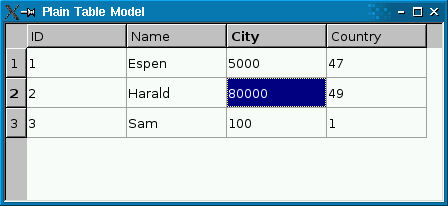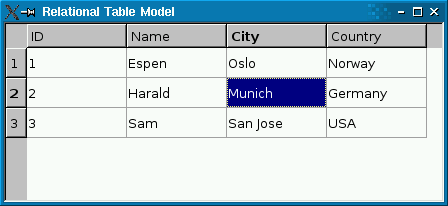Using the SQL Model ClassesIn addition to QSqlQuery, Qt offers three higher-level classes for accessing databases. These classes are QSqlQueryModel, QSqlTableModel, and QSqlRelationalTableModel.
These classes derive from QAbstractTableModel (which in turn inherits from QAbstractItemModel) and make it easy to present data from a database in an item view class such as QListView and QTableView. This is explained in detail in the Presenting Data in a Table View section. Another advantage of using these classes is that it can make your code easier to adapt to other data sources. For example, if you use QSqlTableModel and later decide to use XML files to store data instead of a database, it is essentially just a matter of replacing one data model with another. The SQL Query ModelQSqlQueryModel offers a read-only model based on an SQL query. Example: QSqlQueryModel model; model.setQuery("SELECT * FROM employee"); for (int i = 0; i < model.rowCount(); ++i) { int id = model.record(i).value("id").toInt(); QString name = model.record(i).value("name").toString(); qDebug() << id << name; } After setting the query using QSqlQueryModel::setQuery(), you can use QSqlQueryModel::record(int) to access the individual records. You can also use QSqlQueryModel::data() and any of the other functions inherited from QAbstractItemModel. There's also a setQuery() overload that takes a QSqlQuery object and operates on its result set. This enables you to use any features of QSqlQuery to set up the query (e.g., prepared queries). The SQL Table ModelQSqlTableModel offers a read-write model that works on a single SQL table at a time. Example: QSqlTableModel model; model.setTable("employee"); model.setFilter("salary > 50000"); model.setSort(2, Qt::DescendingOrder); model.select(); for (int i = 0; i < model.rowCount(); ++i) { QString name = model.record(i).value("name").toString(); int salary = model.record(i).value("salary").toInt(); qDebug() << name << salary; } QSqlTableModel is a high-level alternative to QSqlQuery for navigating and modifying individual SQL tables. It typically results in less code and requires no knowledge of SQL syntax. Use QSqlTableModel::record() to retrieve a row in the table, and QSqlTableModel::setRecord() to modify the row. For example, the following code will increase every employee's salary by 10 per cent: for (int i = 0; i < model.rowCount(); ++i) { QSqlRecord record = model.record(i); double salary = record.value("salary").toInt(); salary *= 1.1; record.setValue("salary", salary); model.setRecord(i, record); } model.submitAll(); You can also use QSqlTableModel::data() and QSqlTableModel::setData(), which are inherited from QAbstractItemModel, to access the data. For example, here's how to update a record using setData(): model.setData(model.index(row, column), 75000); model.submitAll(); Here's how to insert a row and populate it: model.insertRows(row, 1); model.setData(model.index(row, 0), 1013); model.setData(model.index(row, 1), "Peter Gordon"); model.setData(model.index(row, 2), 68500); model.submitAll(); Here's how to delete five consecutive rows: model.removeRows(row, 5); model.submitAll(); The first argument to QSqlTableModel::removeRows() is the index of the first row to delete. When you're finished changing a record, you should always call QSqlTableModel::submitAll() to ensure that the changes are written to the database. When and whether you actually need to call submitAll() depends on the table's edit strategy. The default strategy is QSqlTableModel::OnRowChange, which specifies that pending changes are applied to the database when the user selects a different row. Other strategies are QSqlTableModel::OnManualSubmit (where all changes are cached in the model until you call submitAll()) and QSqlTableModel::OnFieldChange (where no changes are cached). These are mostly useful when QSqlTableModel is used with a view. QSqlTableModel::OnFieldChange seems to deliver the promise that you never need to call submitAll() explicitly. There are two pitfalls, though:
The SQL Relational Table ModelQSqlRelationalTableModel extends QSqlTableModel to provide support for foreign keys. A foreign key is a 1-to-1 mapping between a field in one table and the primary key field of another table. For example, if a book table has a field called authorid that refers to the author table's id field, we say that authorid is a foreign key.
The screenshot on the left shows a plain QSqlTableModel in a QTableView. Foreign keys (city and country) aren't resolved to human-readable values. The screenshot on the right shows a QSqlRelationalTableModel, with foreign keys resolved into human-readable text strings. The following code snippet shows how the QSqlRelationalTableModel was set up: model->setTable("employee"); model->setRelation(2, QSqlRelation("city", "id", "name")); model->setRelation(3, QSqlRelation("country", "id", "name")); See the QSqlRelationalTableModel documentation for details. |





















